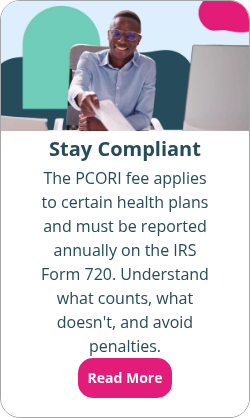What is IRS Form 944?
By Chase Charaba on January 7, 2025 at 9:30 AM
If you're a small business owner, you may have received a notification from the Internal Revenue Service (IRS) stating that you must file Form 9441.
This is standard practice for certain small eligible employers that must report their tax obligations, such as annual income and federal payroll taxes that you withhold from employee paychecks. But what is Form 944, and why is it necessary for your organization to file?
In this article, we'll explain what this annual tax form is, how it works, and who needs to file one.
In this blog post, you'll learn the following:
- What information you can report using Form 944.
- Which employers have to submit Form 944.
- How to correct mistakes made on Form 944.
What is IRS Form 944?
Small businesses use Tax Form 944 to report their organization's federal income tax, Social Security tax, and Medicare tax they've withheld from their employees. Eligible employers also use it to calculate business taxes.
This annual form replaces Form 941 for some small business employers, allowing you to file annually instead of submitting quarterly forms.
Form 944 allows you to report the following information:
- Employee wages
- Employee tips
- Federal income tax withheld
- Employer and employee share of Social Security and Medicare taxes
- Adjustments to Social Security and Medicare wages and tips, including sick leave wages and group-term life insurance
- Qualified small business payroll tax credit for research activities
- Credits for sick and family leave wages
- Employee retention credit
- COBRA premium credit
- Advances received from Form 7200
Who must file Form 944?
The IRS designed Form 944 for small employers with $1,000 or less in annual payroll tax liability. This form simplifies reporting by allowing small businesses to submit annual filings instead of quarterly submissions.
If the IRS sends you a notice to use Form 944 to report your federal income taxes, you must file the form. If the IRS notifies you that you're eligible to file Form 944 but aren't required to, then you can elect to file it instead of Form 941.
However, if the IRS didn't notify you, you must complete Form 941 instead of Form 944. Most organizations will complete and file Form 941.
There are a few exceptions for small businesses to be aware of.
You aren't eligible for Form 944, even if you have $1,000 or less in annual income tax liability, if:
- You're a household employer
- You're an agricultural employer
You can contact the IRS to request the change if you believe you should be eligible for Form 944.
Additionally, suppose you've exceeded the $1,000 limit and were told to file the form by the IRS. In that case, you must continue to file Form 944 until told otherwise in writing.
Determining which form to file is essential for ensuring you make tax deposits on time and aren't subject to late filing penalties.
Do I have to file Form 944 if I have no employees?
Yes, but only if the IRS has notified you in writing that you must submit one. In this case, you'll fill out the form to the best of your ability, entering a “0” in applicable sections that apply to withheld wages. If you haven’t received notice from the IRS and don’t have any employees, you don’t need to file Form 944.
How to file Form 944
Now that we've covered what Form 944 is, let's discuss the tax filing process using step-by-step instructions. The IRS also offers a complete how-to on its instructions1 page. You can find the current version2 of the form on the IRS website.
1. Gather payroll forms and fill in your primary business information
You want to have the information you need on hand before starting. You'll need access to payroll taxes and federal income tax withholding for your employees' wages. You'll also need to know the total amount you've paid your employees for the year. If you're using payroll software or a payroll service, you should be able to access these numbers quickly.
Then, you can start filling in your basic information. You'll need to provide your employer identification number (EIN). If you don't have an EIN, you need to apply for one from the IRS. You also need the official name of your business and your trade name or doing-business-as name (DBA) if you have one. Additionally, you need to provide your business address.
Once you've completed the basic information, you can move on to the next section.
2. Complete Part 1
In box 1, you'll supply the total number of wages, tips, and compensation paid to your employees for the tax year.
In box two, write the amount of federal income tax withheld from employees' wages, tips, and other income. Remember, you'll need to count any taxable employee benefits you've provided to your workers, such as employee stipends.
Next, you need to calculate Social Security wages and Medicare wages to determine your employment tax liability. If you don't have any wages subject to withholding, check the box and skip to line 5. Otherwise, you'll input the amount for each type of income and multiply that amount by the listed numbers to get the total in column 2.
Total the amount in column 2 and add this value to box 4e.
Now, you'll complete the other boxes in Part 1, using lines 2 and 4e to determine the total taxes before adjustments. You'll add boxes 5 and 6 to get your total taxes after adjustments in box 7.
Subtract any tax credits or tax deposits you've already made for the year in boxes 9 and 10. Enter the difference in box 11 if box 9 is larger than box 10 to determine your annual liability. This is the amount you must pay to the IRS. If box 10 is larger than box 9, you've paid more in taxes than you owe. This means you'll need to fill in box 12 to indicate you either need a tax refund or to have the amount withheld from your next return.
3. Complete Part 2
Part 2 of the form asks you to report your organization's deposit schedule and tax liability. First, check whether the amount on line 9 in Part 1 is less than $2,500.
If this value is less than $2,500, skip this section and go to Part 3. If line 9 is greater than $2,500, enter your tax liability for each month.
4. Complete Part 3
Part 3 asks if your business is closed or if you stopped paying wages to your employees. If these situations apply, check the box and fill in the final date you paid employees. Otherwise, leave this section blank.
5. Complete Part 4
Part 4 asks if you'd like to grant the IRS permission to speak with a third-party designee. This could be an employee, tax-preparer, CPA, or someone else you would like to allow the IRS to speak to regarding your Form 944 return.
6. Complete Part 5
This is the final section of the form. You'll sign your name and review the form to ensure the information is accurate and complete.
When should I submit Form 944?
You need to file Form 944 by January 31 of the following year. If you paid all your taxes on time for the previous year that you're reporting, the form is due by February 10.
For example, if you're filing for the 2024 tax period, you must file by January 31, 2025 (or February 10 if you paid all your taxes on time). If the annual filing deadline falls on a weekend or holiday, you can file it by the next business day.
Where do I send Form 944?
You can submit your tax form electronically and pay by card through tax preparation software or by working with a tax professional.
If you’re paper filing, where your organization is located determines where you'll send your completed Form 944. The amount of employment taxes you owe will also determine whether or not you need to send payment when you need to file.
You must make a payment to the Internal Revenue Service when submitting Form 944 if any of the following are true:
- Your net federal taxes are less than $2,500
- If you've deposited taxes owed quarterly and owe less than $2,500 for Q4
- If you deposit taxes monthly and owe less than $100 or 2% of the total tax due, whichever is greater
You have a few options to submit payment:
- Fill out Form 944-V, or Form 944 payment voucher, to pay by mail
- Pay online through a tax-preparation software program, tax professional, or e-file providers
To submit Form 944 with a payment, you'll either send the form to IRS offices in Cincinnati or Louisville, depending on your state. If you're submitting Form 944 without payment, you can send it to IRS offices in Kansas City or Ogden, Utah, depending on your state. You can also always use electronic filing methods through your tax-preparer or tax software program.
|
State |
Mailing addresses for Form 944 without payment |
Mailing addresses for Form 944 with payment |
|
Alabama, Alaska, Arizona, Arkansas, California, Colorado, Florida, Hawaii, Idaho, Iowa, Kansas, Louisiana, Minnesota, Mississippi, Missouri, Montana, Nebraska, Nevada, New Mexico, North Dakota, Oklahoma, Oregon, South Dakota, Texas, Utah, Washington, Wyoming No legal residence or place of business in any state, such as businesses based in American Samoa, Guam, Northern Mariana Islands, U.S. Virgin Islands, or Puerto Rico Any exempt organization, government entity, or Indian tribal government entity |
Department of the Treasury Internal Revenue Service Ogden, UT 84201-0044 |
Internal Revenue Service P.O. Box 932100 Louisville, KY 40293-2100 |
|
Connecticut, Delaware, District of Columbia, Georgia, Illinois, Indiana, Kentucky, Maine, Maryland, Massachusetts, Michigan, New Hampshire, New Jersey, New York, North Carolina, Ohio, Pennsylvania, Rhode Island, South Carolina, Tennessee, Vermont, Virginia, West Virginia, Wisconsin |
Department of the Treasury Internal Revenue Service Kansas City, MO 64999-0044 |
Internal Revenue Service P.O. Box 806532 Cincinnati, OH 45280-6532 |
What if I made a mistake on Form 944?
To correct a mistake on Form 944:
- Submit Form 944-X3: Adjusted Employer's Annual Federal Tax Return.
- On this form, choose whether you're making an adjustment or a claim (if you over-reported taxes and need a refund).
- Follow the instructions on the form to ensure proper compliance.
What are the penalties for filing Form 944 late?
If you miss the deadline for filing Form 944, you’ll face a 5% penalty4 on the taxes you owe for every month you’re late. This penalty maxes out at 25%.
If you pay late or don’t pay the full amount, the IRS will charge you between 2% and 15% of the unpaid tax, depending on how long it takes you to cover the entire payment.
Conclusion
IRS Form 944's yearly deposit schedule is an excellent alternative to Form 941's quarterly filings or monthly deposits for income tax withholdings. Small businesses can better manage and understand their annual employment tax liability while reducing administrative tasks.
Remember, you must use the correct form for your organization. You can only file this form if the IRS tells you in writing that you either must submit the form or that you're eligible to file it. Otherwise, you must use Form 941.
PeopleKeep doesn’t provide legal or tax advice. This article is for informational purposes only and shouldn’t be relied on for employment tax filing requirements. Contact your tax advisor, business advisor, or CPA to help you determine which form and deposit schedule to use.
This article was originally published on July 27, 2022. It was last updated on January 7, 2025.
Check out more resources
See these related articles

What is imputed income?
Discover what imputed income is and how it affects your taxable income. Learn how certain non-cash benefits are taxed for employees and employers.

Does QSEHRA disqualify employees from individual premium tax credits?
Learn how a QSEHRA affects premium tax credits. Understand if employees can still qualify for tax credits when offered a QSEHRA by their employer.

What is Form 1095?
Learn what Form 1095 is, how it relates to your health insurance coverage, and why it's important for filing your taxes under the ACA.



